BUICK CENTURY 1997 Service Manual
Manufacturer: BUICK, Model Year: 1997, Model line: CENTURY, Model: BUICK CENTURY 1997Pages: 406, PDF Size: 20.64 MB
Page 41 of 406
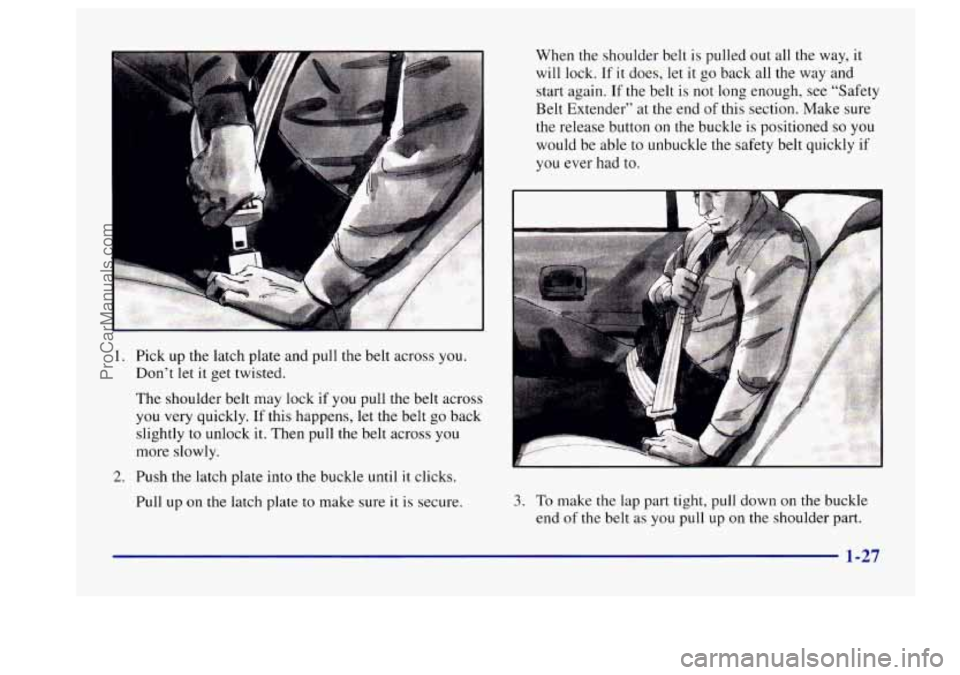
1.
2.
A
Pick up the latch plate and pull the belt across you.
Don’t let
it get twisted.
The shoulder belt may lock
if you pull the belt across
you very quickly. If this happens, let the belt go back
slightly to unlock it.
Then pull the belt across you
more slowly.
Push the latch plate into the buckle
until it clicks.
Pull up on the latch plate to make sure
it is secure. When the
shoulder belt is pulled out all the
way, it
will lock. If it does, let it go back all the way and
start again.
If the belt is not long enough, see “Safety
Belt Extender” at the end of this section. Make sure
the release button
on the buckle is positioned so you
would be able to unbuckle the safety belt quickly if
you ever had to.
I
3. To make the lap part tight, pull down on the buckle
e.nd
of the belt as you pull up on the shoulder part.
1-27
ProCarManuals.com
Page 42 of 406

The lap part of the belt should be worn low and snug on
the hips, just touching the thighs.
In a crash, this applies
force to the strong pelvic bones. And you’d be less likely \
to slide
under the lap belt. If you slid under it, the belt
would apply force at your abdomen. This could cause
serious or even fatal injuries. The shoulder belt should
go
over the shoulder and across the chest. These parts of the
body
are best able to take belt restraining forces.
The safety belt locks if there’s a sudden stop or a crash,
or if you pull
the belt very quickly out of the retractor.
You can be seriously hurt if your shoulder belt is
too loose. In
a crash, you would move forward
too much, which could increase injury. The
shoulder belt should fit against your body.
To unlatch the belt, just push the button on the buckle.
1-2s
ProCarManuals.com
Page 43 of 406
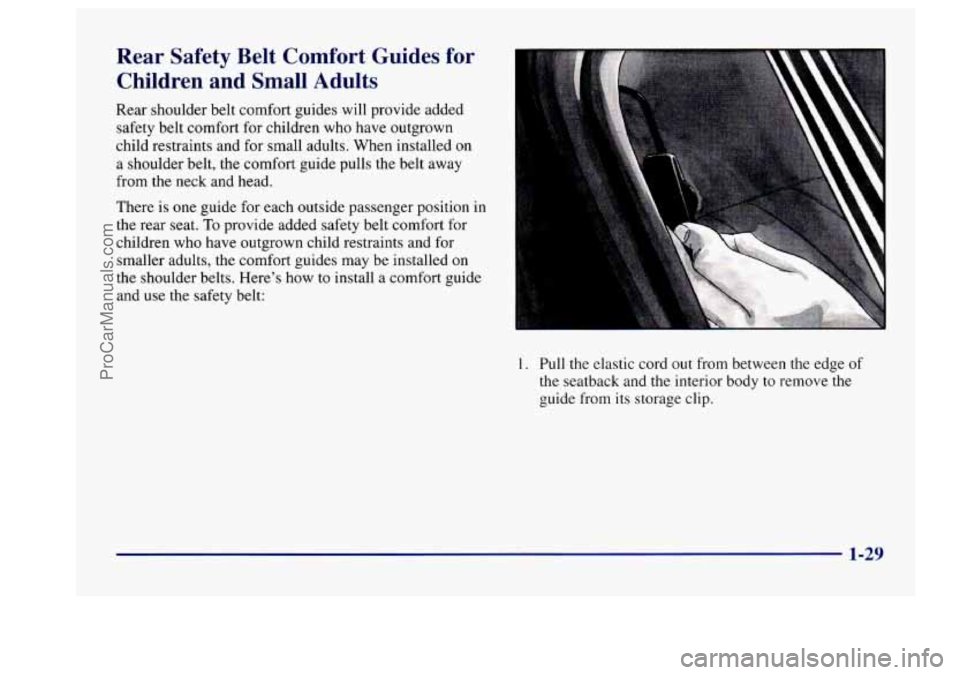
Rear Safety Belt Comfort Guides for Children and Small Adults
Rear shoulder belt comfort guides will provide added
safety belt comfort for children who have outgrown
child restraints and for small adults. When installed
on
a shoulder belt, the comfort guide pulls the belt away
from the neck and head.
There is one guide for each outside passenger position in
the rear seat.
To provide added safety belt comfort for
children who have outgrown child restraints and for
smaller adults, the comfort guides may be installed
on
the shoulder belts. Here’s how to install a comfort guide
and use the safety belt:
1. Pull the elastic cord out from between the edge of
the seatback and the interior body to remove
the
guide from its storage clip.
1-29
ProCarManuals.com
Page 44 of 406
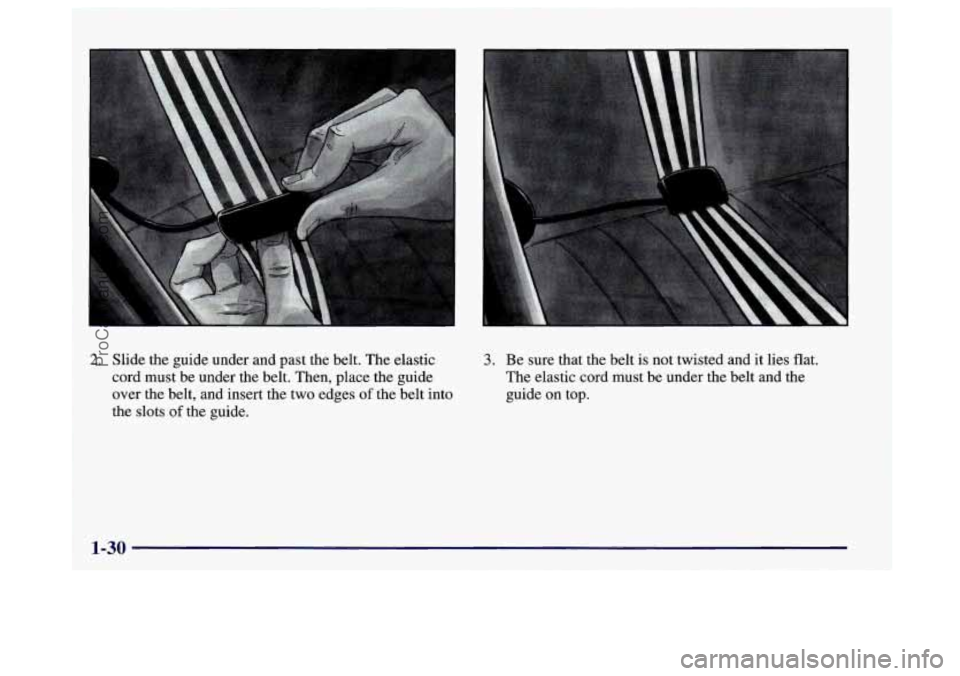
2. Slide the guide under and past the belt. The elastic
cord must be under
the belt. Then, place the guide
over the belt, and insert the two edges
of the belt into
the slots
of the guide.
3. Be sure that the belt is not twisted and it lies flat.
The elastic cord must be under the belt and the
guide
on top.
1-30
ProCarManuals.com
Page 45 of 406
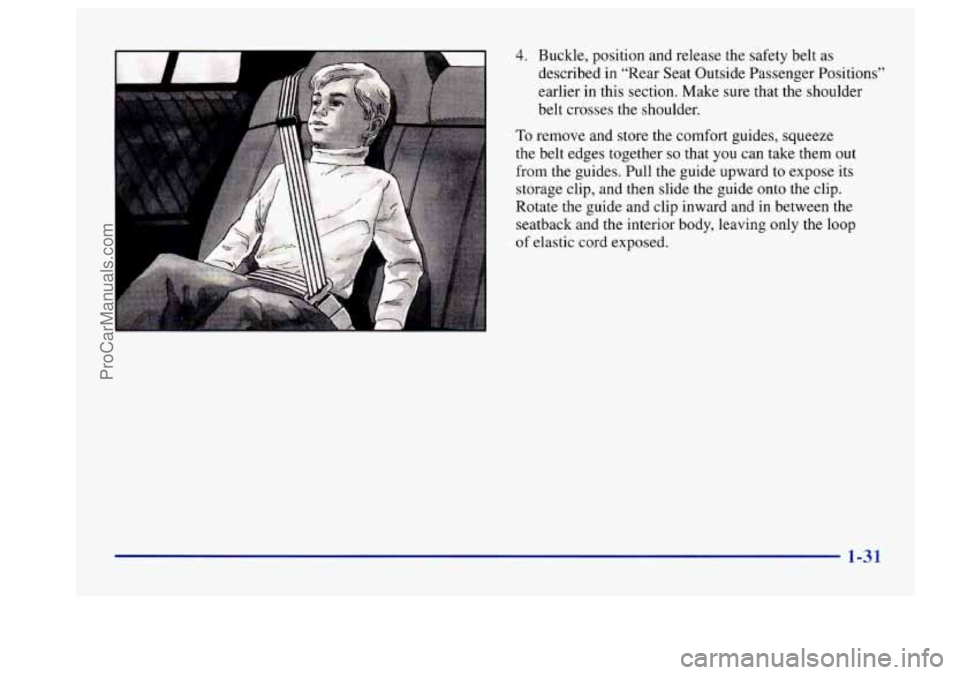
4. Buckle, position and release the safety belt as
described in “Rear Seat Outside Passenger Positions”
earlier in this section. Make sure that the shoulder
belt crosses the shoulder.
To remove and store the comfort guides, squeeze
the belt edges together
so that you can take them out
from the guides. Pull the guide upward to expose its
storage clip, and then slide the guide
onto the clip.
Rotate the guide and clip inward and in between the
seatback and the interior body, leaving only the loop
of elastic cord exposed.
1-31
ProCarManuals.com
Page 46 of 406
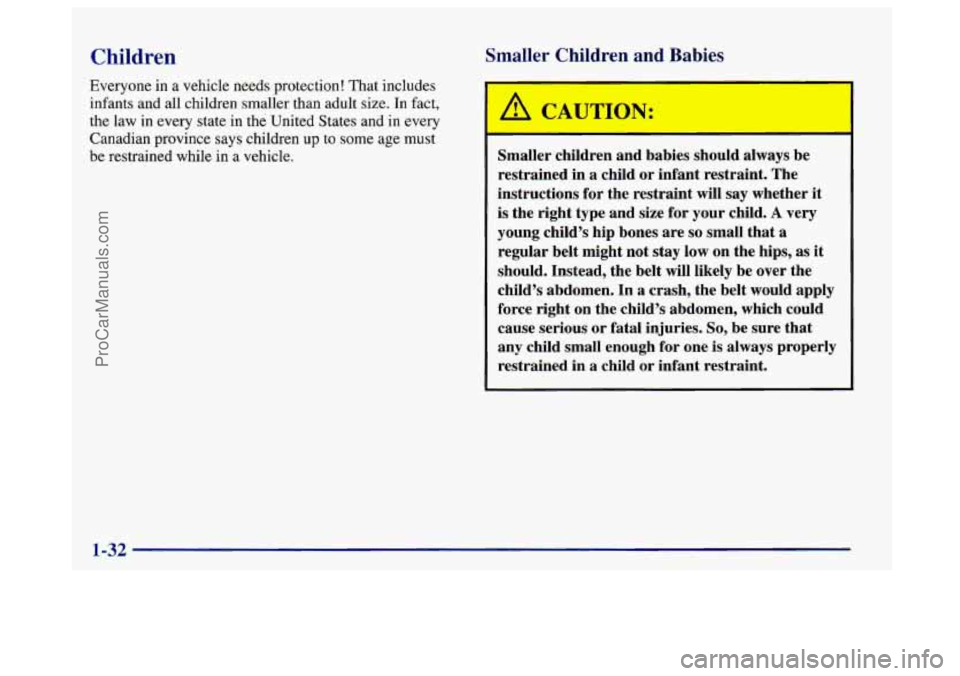
Children
Everyone in a vehicle needs protection! That includes
infants and all children smaller than adult size.
In fact,
the law in every state in the United States and in
every
Canadian province says children up to some age must
be restrained while in a vehicle.
Smaller Children and Babies
LA CAUTION:
Smaller children and babies should always be
restrained in a child
or infant restraint. The
instructions
for the restraint will say whether it
is the right type and size for your child.
A very
young child’s hip bones are
so small that a
regular belt might
not stay low on the hips, as it
should. Instead, the belt will likely be over the
child’s abdomen. In a crash, the belt would apply
force right on the child’s abdomen, which could
cause serious or fatal injuries.
So, be sure that
any child small enough for one is always properly
restrained in a child or infant restraint.
1-32
ProCarManuals.com
Page 47 of 406
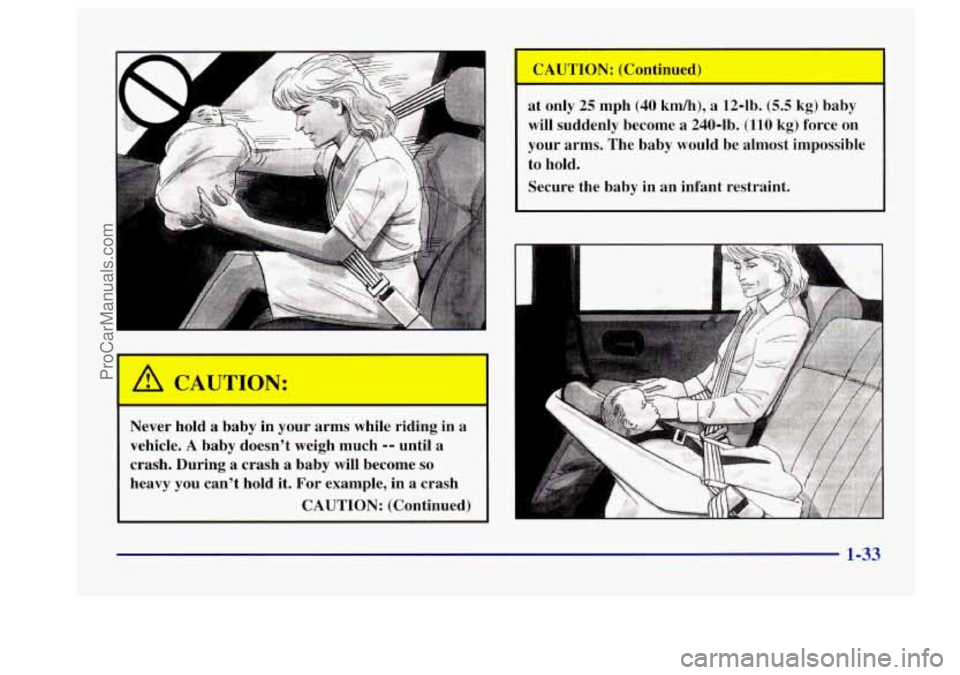
A
A CAUTION:
Never hold a baby in your arms while riding in a
vehicle.
A baby doesn’t weigh much -- until a
crash. During
a crash a baby will become so
heavy you can’t hold it. For example, in a crash
CAUTION: (Continued) at
only 25 mph (40
km/h), a 12-lb. (5.5 kg) baby
will suddenly become a 240-lb.
(110 kg) force on
your arms. The baby would be almost impossible
to hold.
Secure the baby in an infant restraint.
J
1-33
ProCarManuals.com
Page 48 of 406
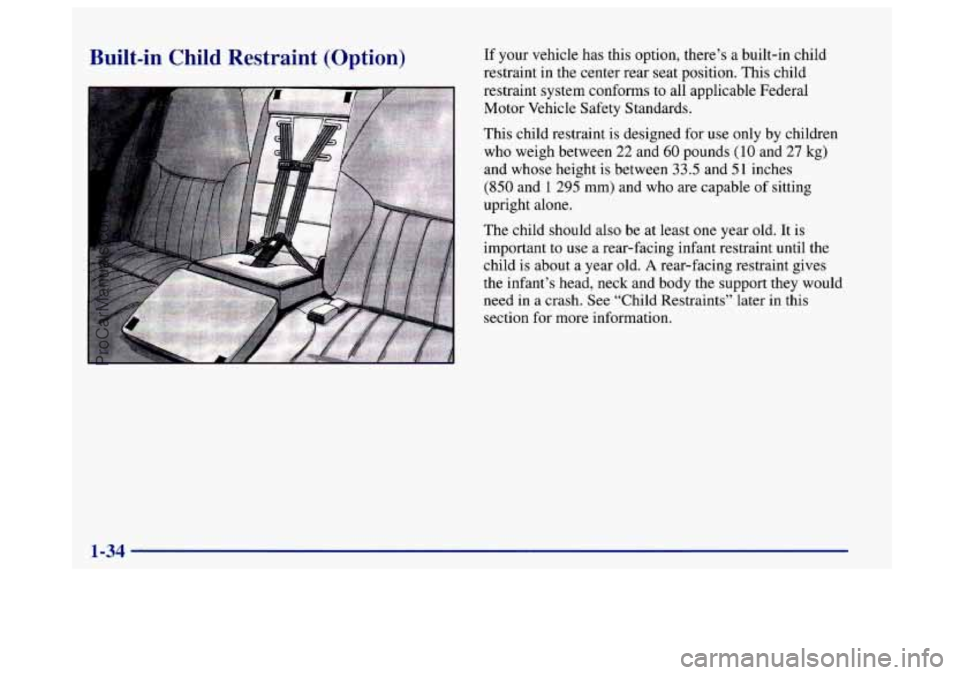
Built-in Child Restraint (Option) If your vehicle has this option, there’s a built-in child
restraint in the center rear seat position. This chld
restraint system conforms
to all applicable Federal
Motor Vehicle Safety Standards.
This child restraint is designed for use only by children
who weigh between
22 and 60 pounds (10 and 27 kg)
and whose height is between 33.5 and 5 1 inches
(850 and 1 295 mm) and who are capable of sitting
upright alone.
The child should also be at least one year old. It is
important
to use a rear-facing infant restraint until the
child is
about a year old. A rear-facing restraint gives
the infant’s head, neck and body the support they would
need in
a crash. See “Child Restraints’’ later in this
section for more information.
1-34
ProCarManuals.com
Page 49 of 406
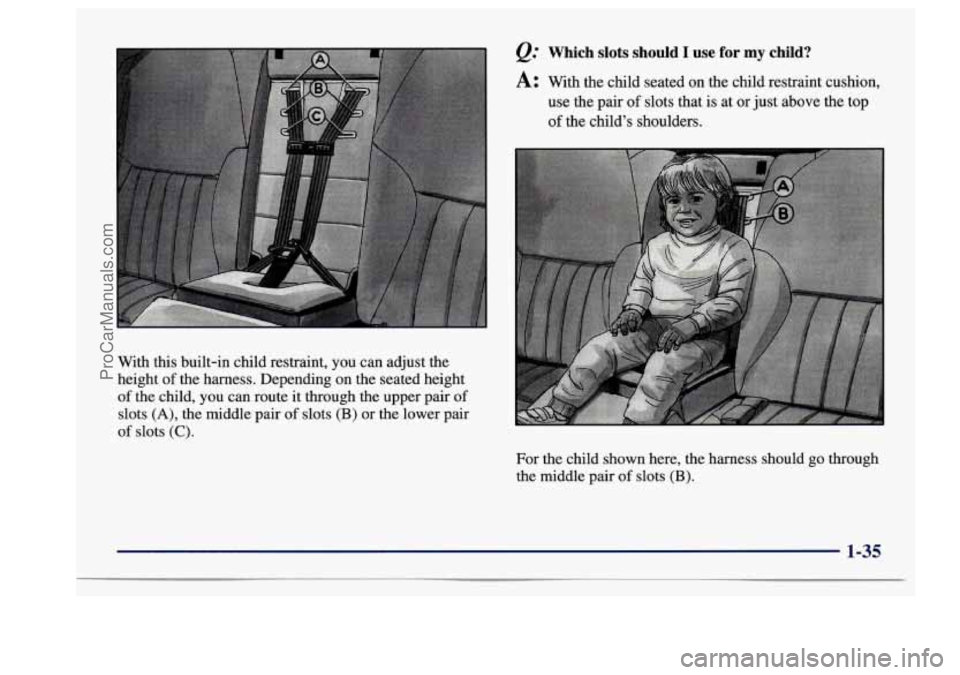
e.' Which slots should I use for my child?
A: With the child seated on the child restraint cushion,
use the pair
of slots that is at or just above the top
of the child's shoulders.
With this built-in child restraint, you can adjust the
height
of the harness. Depending on the seated height
of the child, you can route it through the upper pair of
slots (A), the middle pair of slots (B) or the lower pair
of slots (C).
For the child shown here, the harness should go through
the middle pair
of slots (B).
1-35
ProCarManuals.com
Page 50 of 406
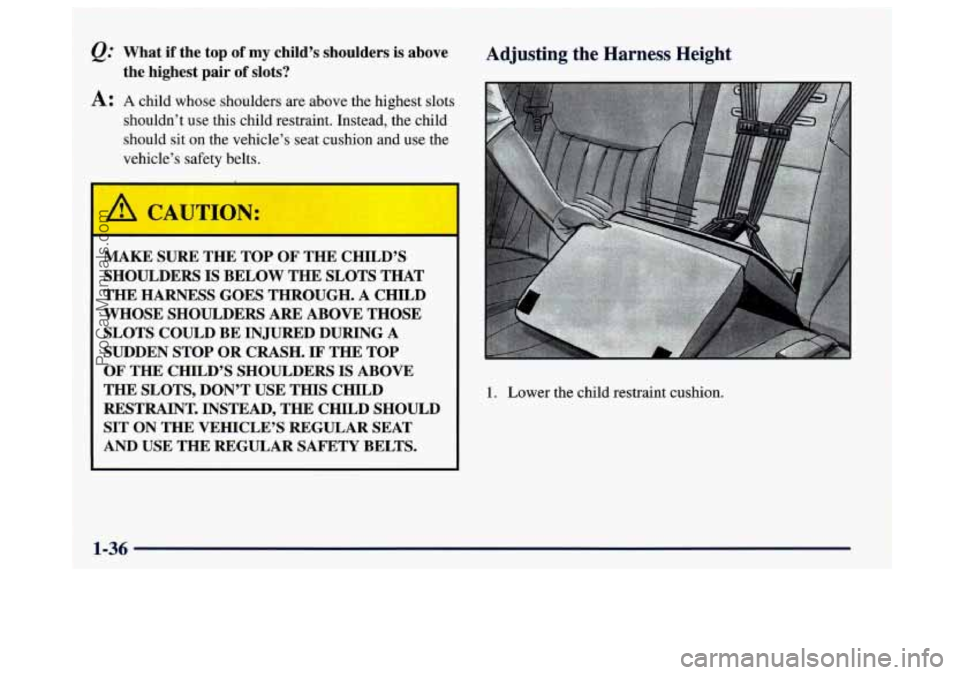
@ What if the top of my child’s shoulders is above
A: A child whose shoulders are above the highest slots
the highest pair of slots?
shouldn’t use this child restraint. Instead, the child
should sit on the vehicle’s seat cushion and use the
vehicle’s safety belts.
MAKE SURE THE TOP OF THE CHILD’S
SHOULDERS
IS BELOW THE SLOTS THAT
THE HARNESS GOES THROUGH.
A CHILD
WHOSE SHOULDERS ARE ABOVE THOSE
SLOTS COULD BE INJURED DURING
A
SUDDEN STOP OR CRASH.’IF THE TOP
OF THE CHILD’S SHOULDERS IS ABOVE
THE SLOTS, DON’T
USE THIS CHILD
RESTRAINT. INSTEAD, THE CHILD SHOULD
SIT
ON THE VEHICLE’S REGULAR SEAT
AND USE THE REGULAR SAFETY BELTS.
Adjusting the Harness Height
1. Lower the child restraint cushion.
1-36
ProCarManuals.com